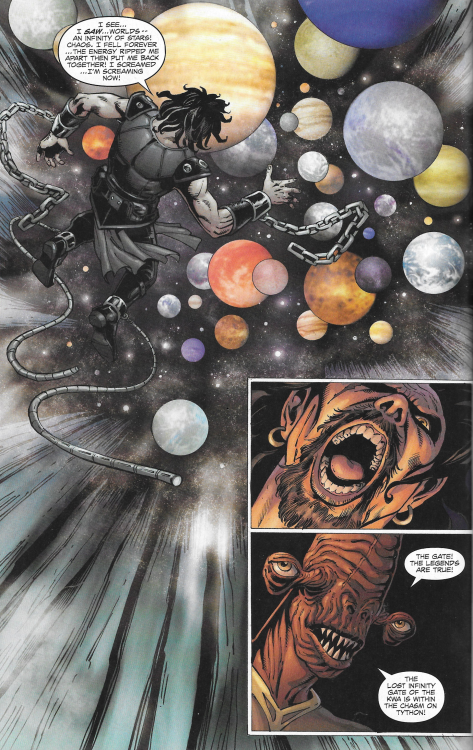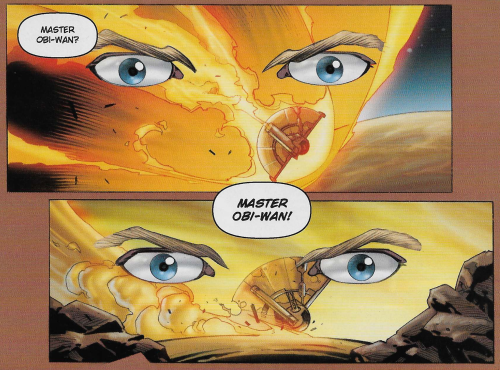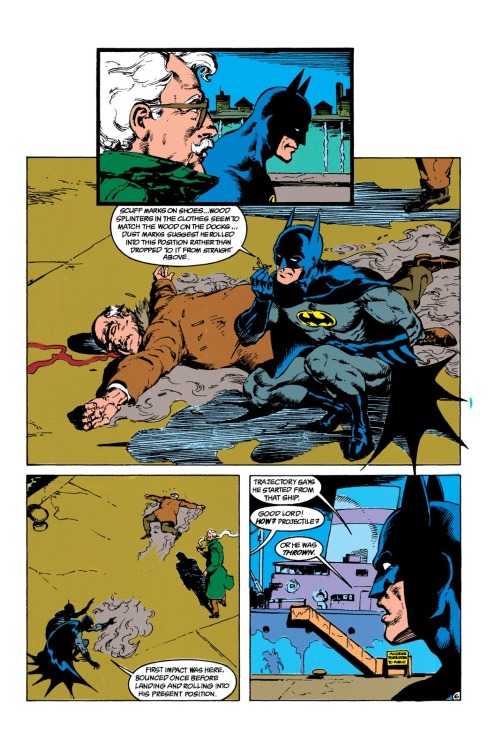#john ostrander
Happy Star Wars Day!
Two years ago, I wrote about young Anakin’s strange vision of the future; last year, I wrote about old Ulic Qel-Droma’s tragic vision of the past. This year, I thought I’d write about the natural next step: old Daegen Lok’s terrifying vision of infinity.
I expounded briefly but extravagantly upon my love for Daegen Lok once before; I’ll try to be clearer here. Daegen and Xesh form the core master-student relationship of the excellent 15-part Dawn of the Jedi comic series. Never were two souls more haunted by their own dark deeds, oppressed by the cruel systems around them, nor tormented by the sheer, cold majesty of the Force than Messrs. L and X. Obi-Wan and Anakin? They had it easy. Kreia and the Exile? That’s nothing. Cere and Trilla? No, the boys definitely suffered more. (Alright, apparently when it comes to DotJ I mustbe extravagant.)
Daegen’s Force-vision, which takes place just before the story begins, has two layers: the first like Cassandra’s, and the second like Zaphod Beeblebrox’ (pictured). As a young and reckless knight fresh off a bloody victory, he descends into the forbidden cavern below the Temple with his buddy Hawk Ryo to see what they can see. Their first, more plot-heavy vision foretells of another war, heralded by a mighty young man with a glowing stick (new at the time). When they try to warn their elders to prepare, they are threatened with exile for their disobedience. Hawk betrays Daegen (cue homoerotic subplot) and Daegen is banished to the moon, where he becomes the titular Prisoner of Bogan until Xesh and the proto-lightsaber fall right into his lap. Since no one believes Daegen about the war, he takes matters into his own hands and prepares his own army of crooks and ne’er-do-wells against the impending alien invaders. Xesh follows along until his love triangle plot kicks in; of course, heterosexuality was the one thing Daegen could not have foreseen.
But the second layer of Daegen’s vision is the thing that really fucks him up. If you’ve read Hitchhiker’s Guide to the Galaxy, you might remember the scene where they try to torture Zaphod by impressing upon him the immensity of the galaxy. While Zaphod is too egotistical for it to work, Daegen is not. The true identity of the mysterious chasm is revealed to him: it is a portal that can take one anywhere in the universe! (It’s also a reference to my least favorite Quinlan Vos comic.) The elders always said the chasm would drive any visitors mad, and this overwhelming awareness is why.
Nevertheless, though Daegen has gone insane because of the second thing, he is still right about the first thing. And while Hawk takes the easy path of conformity and self-denial, Daegen never wavers from his terrible truth, which is very sexy and transgender of him.
As far as the illustration goes, it is simpler than those of the other two visions I discussed. The vision is technically full-page, but the inserts don’t allow it to dominate the scene, which is just too bad. In the limited space available, Jan Duursema does the “sky full of beachballs” trick which is also utilized in Anakin’s vision, is a staple of Al Williamson’s compositions, and is honestly most effective in Michael Murnane’s conclusion to the epic Wat Tambor one-shot. This visual trick actually makes the universe look small, which is usually a great choice for Star Wars, where transportation is hardly the physics-straining problem that it is in harder sci-fi. That is the exact opposite of what Daegen’s cosmic-horror vision is supposed to convey, but Duursema’s expressive figure and face make the intended emotions obvious anyway.
“Dawn of the Jedi: Force War,” issue 3. Dark Horse. January 15, 2014. Writer and co-plotter: John Ostrander. Penciller and co-plotter: Jan Duursema. Inker: Dan Parsons. Letterer: Michael Heisler. Colorist: Wes Dzioba.
Post link

Don’t you love how these Star Wars reference books never give any credit to the comic book writers and artists who came up with this stuff originally?
It’s amazing to me that Dave Filoni gets more credit for something he didn’t make than John Ostrander and Jan Duursema get for one of strongest SW characters with one of the most sophisticated and satisfying storylines of them all.
This unevenness is one of the consequences of the frustrating and silly divide between “legends” and “canon” that I just don’t engage with on this blog. And of course, while I won’t deny that movies > TV shows > games > novels > comics in terms of budget and popularity, I will argue that that order is certainly not the case in terms of originality, imagination, or storytelling quality.
“Star Wars: The Lightsaber Collection.” October 20, 2020. Writer: Daniel Wallace. Illustrators: Lukasz Liszko and Ryan Valle.
It’s Anakin Week and Clone Wars Friday!
I love this T.J. Eckleburg-Force-Vision thing for him. You onlysee this shit in comics.
“Republic 62: No Man’s Land.” Dark Horse. March 17, 2004. Writer: John Ostrander. Penciller: Tomás Giorello. Letterer: Michael David Thomas. Colorist: Brad Anderson.
Post link
Who Watched The Watchmen?: Watchmen’s Legacy on… DC’s Legends - Comic Book Herald
My good friend - and as of now, dread nemesis - @deathchrist2000 is heading up the new Comic Book Herald series Who Watched The Watchmen? on the legacy of ‘the greatest comic of all time’, with tons of great pieces from excellent writers coming up. I was given the honor of kicking off the feature. I was given the agony of doing so by rereading, and thinking at length about, DC Comics’ Legends.





